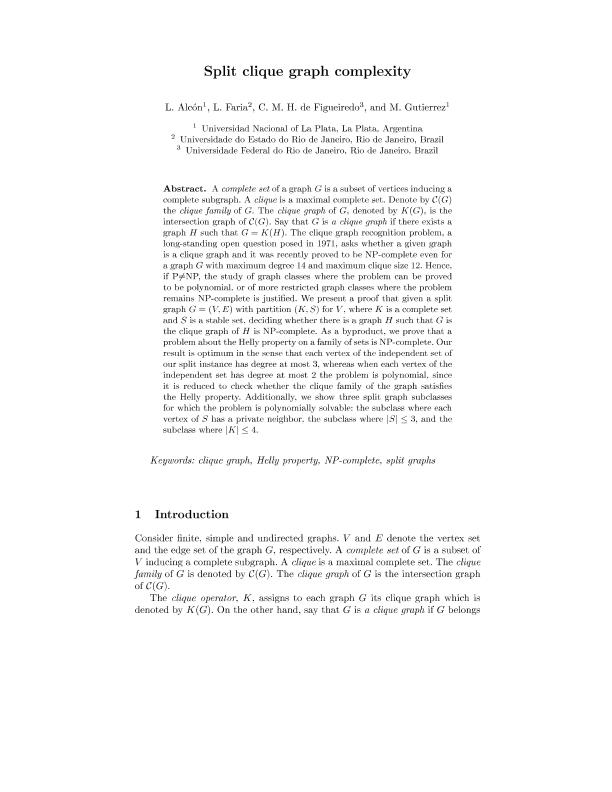Mostrar el registro sencillo del ítem
dc.contributor.author
Alcón, Liliana Graciela

dc.contributor.author
Faria, Luerbio
dc.contributor.author
De Figueiredo, Celina M.H.
dc.contributor.author
Gutierrez, Marisa

dc.date.available
2020-01-20T14:15:01Z
dc.date.issued
2013-09
dc.identifier.citation
Alcón, Liliana Graciela; Faria, Luerbio; De Figueiredo, Celina M.H.; Gutierrez, Marisa; Split Clique Graph complexity; Elsevier Science; Theoretical Computer Science; 506; 9-2013; 29-42
dc.identifier.issn
0304-3975
dc.identifier.uri
http://hdl.handle.net/11336/95177
dc.description.abstract
A complete set of a graph G is a subset of vertices inducing a complete subgraph. A clique is a maximal complete set. Denote by C(G) the clique family of G. The clique graph of G, denoted by K(G), is the intersection graph of C(G). Say that G is a clique graph if there exists a graph H such that G=K(H). The clique graph recognition problem, a long-standing open question posed in 1971, asks whether a given graph is a clique graph and it was recently proved to be NP-complete even for a graph G with maximum degree 14 and maximum clique size 12. Hence, if P ≠ NP, the study of graph classes where the problem can be proved to be polynomial, or of more restricted graph classes where the problem remains NP-complete is justified. We present a proof that given a split graph G=(V,E) with partition (K,S) for V, where K is a complete set and S is a stable set, deciding whether there is a graph H such that G is the clique graph of H is NP-complete. As a byproduct, we prove that determining whether a given set family admits a spanning family satisfying the Helly property is NP-complete. Our result is optimum in the sense that each vertex of the independent set of our split instance has degree at most 3, whereas when each vertex of the independent set has degree at most 2 the problem is polynomial, since it is reduced to the problem of checking whether the clique family of the graph satisfies the Helly property. Additionally, we show three split graph subclasses for which the problem is polynomially solvable: the subclass where each vertex of S has a private neighbor, the subclass where |S|≤3, and the subclass where |K|≤4.
dc.format
application/pdf
dc.language.iso
eng
dc.publisher
Elsevier Science

dc.rights
info:eu-repo/semantics/openAccess
dc.rights.uri
https://creativecommons.org/licenses/by-nc-sa/2.5/ar/
dc.subject
CLIQUE GRAPHS
dc.subject
HELLY PROPERTY
dc.subject
NP-COMPLETE
dc.subject
SPLIT GRAPHS
dc.subject.classification
Ciencias de la Computación

dc.subject.classification
Ciencias de la Computación e Información

dc.subject.classification
CIENCIAS NATURALES Y EXACTAS

dc.title
Split Clique Graph complexity
dc.type
info:eu-repo/semantics/article
dc.type
info:ar-repo/semantics/artículo
dc.type
info:eu-repo/semantics/publishedVersion
dc.date.updated
2020-01-15T20:01:26Z
dc.journal.volume
506
dc.journal.pagination
29-42
dc.journal.pais
Países Bajos

dc.journal.ciudad
Amsterdam
dc.description.fil
Fil: Alcón, Liliana Graciela. Consejo Nacional de Investigaciones Científicas y Técnicas; Argentina. Universidad Nacional de La Plata; Argentina
dc.description.fil
Fil: Faria, Luerbio. Universidade do Estado de Rio do Janeiro; Brasil
dc.description.fil
Fil: De Figueiredo, Celina M.H.. Universidade Federal do Rio de Janeiro; Brasil
dc.description.fil
Fil: Gutierrez, Marisa. Universidad Nacional de La Plata; Argentina. Consejo Nacional de Investigaciones Científicas y Técnicas; Argentina
dc.journal.title
Theoretical Computer Science

dc.relation.alternativeid
info:eu-repo/semantics/altIdentifier/url/https://www.sciencedirect.com/science/article/pii/S0304397513005367
dc.relation.alternativeid
info:eu-repo/semantics/altIdentifier/doi/http://dx.doi.org/10.1016/j.tcs.2013.07.020
Archivos asociados
